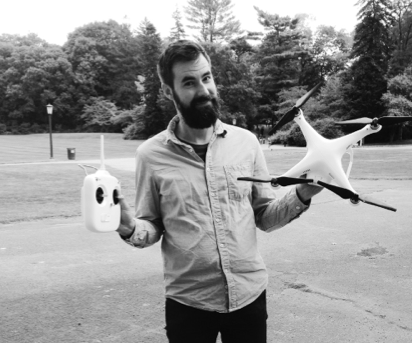By Alec Matuszak
Staff Writer
The word “drone” is defined in the dictionary as a verb and a noun. The verb relates to a continuous sound that can be made. As a noun, it is often associated with a type of bee. One last definition, however, has been the subject of much recent controversy and interest. Nowadays, a “drone” also refers to “a remote-controlled pilotless aircraft or missile.”

Photo: Alyssa Seidman
On Tuesday, Sept. 29, Assistant Professor of Media Arts, Benjamin Gerdes, spoke during common hour about drones as part of the College of Arts, Communication and Design Dean’s Lecture series.
Gerdes relates his interest in drones to his interest in cinema and video production. “I started working in film and video because it had a kind of charge or potential to me, but also, there were just certain shots that you just feel ‘that does something for me’,” said Gerdes during his lecture. Although shorter shots and small scenes do not tell the entire story of a film, these short clips are what Gerdes finds most fascinating. “Sometimes it’s not necessarily about a literal meaning…but what does this convey? And from my own perspective, it means something,” he said.
Gerdes first became interested in drones once he noticed the shift in the way drones were being covered by the media and the public. “We are in the middle of a big shift in terms of drones being an international topic about the U.S military, to being a consumer, domestic technology,” he said.
Perspective is a good word to use when describing drones, as they provide a viewpoint that is otherwise hard to achieve. “I was most excited about the moment where it accelerates quickly and takes off from the grass as a piece of imagery,” Gerdes said. Although drones are most often used to fly from place to place, using drones as a visual tool “relates to the entire history of film and video,” Gerdes added.
According to Gerdes, as filming techniques became more and more widespread, the use of particular lenses and effects began to die out, as it became a mainstream part of the filmmaking process. He finds the same similarities with drone use. “That tension to me between seamless flight and someone making choices is an interesting thing about [drone] footage,” Gerdes said.
Since the use of drones does not yet have an established specific purpose for filmmakers, Gerdes raised the question to his audience “If someone in the future discovered a drone, what kind of tool would they think that was?”
With the U.S. Military conducting controversial drone strikes, many are pondering whether or not drone access should be restricted. There is ongoing discussion on who should be able to access, possess, and use drones. At this point, there does not seem to be a definite answer on how, or if, access should be regulated. According to Gerdes, there should be some middle ground. “You don’t want a completely unregulated environment,” he said.
Robert Riepe, a sophomore Broadcasting major, attended Gerdes’ lecture. Having a familiarity with drones through “observation and industry media,” he cited a few practical real world uses for drones, besides basic traveling from one GPS coordinate to another.
“In South Korea, drones are used in and outside of stadiums to get a grand view of the audience entering or leaving,” Riepe said.
Drones are still a new, rapidly evolving technology that will continue to provide us with ways to accomplish tasks. Exactly what tasks, however, remains to be seen.



Be First to Comment